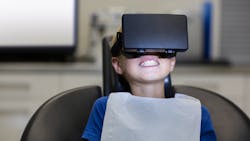Anxiety and dental care
As dental professionals, we treat a variety of patients. Patients, particularly long-standing ones, enjoy coming to the practice for both treatment and conversation. Yet there are many patients for whom a visit to the dentist or hygienist brings on anxiety. Whether the fear is from bad experiences, the unknown, loss of control, or not having been to the office for an extended period, some people dread sitting in our chairs.
Many methods have been discussed to alleviate patient fear and anxiety during treatment, ranging from medication to distraction techniques. There are two basic types of dental fear—dental phobias and dental anxiety. While these have been considered to be one and the same, they are two different experiences.
Dental anxiety
A phobia is a persistent and irrational fear of a specific object, activity, or situation that leads to a compelling desire to avoid it.1 Anxiety is the distress or uneasiness of mind caused by fear of danger or misfortune.2 It has been estimated that 9% to 15% of Americans avoid going to the dentist because of anxiety and fear.3 Dentally anxious patients may keep their appointments and then complain about them, while dental phobic patients may never schedule, may cancel appointments, or may disappear from the practice.
Due to their desire to avoid dental appointments at all costs, phobic patients, when they finally come to the office, may have substantial oral disease due to lack of professional care. Since dental phobias can be severe, these are best handled by a licensed psychological counselor. Counseling can delve into the myriad concerns and issues that a phobic patient may be harboring and assist the patient in overcoming them.
Studies have demonstrated a strong association between dental fear, poor oral health, and adverse childhood/family experiences, such as domestic violence, parental incarceration, mental illness, lack of access to health care, and drug abuse. An adverse childhood event increases the risk of developing oral diseases due to racial and socioeconomic factors and dental phobias.4
Anxious patients may be treated comfortably in the practice with a variety of methods. Greeting the patient with a smile, asking questions, explaining all of the procedures and financial considerations, and using anesthetic techniques as appropriate all aid in reducing an anxious patient’s stress.
A new and growing solution
One area that has been shown to decrease anxiety is virtual reality (VR). VR is an immersive and realistic simulation into a three-dimensional environment. This is created using interactive software and hardware, and it’s experienced or controlled by movement of the body.5 There are numerous studies in medicine that discuss the benefits of VR in alleviating a number of anxiety and psychological disorders.6 A 2004 article in Cyberpsychology and Behavior discussed the use of VR for dental pain control. The results suggested that immersive VR merits more attention as a potentially viable adjunctive nonpharmacologic analgesia for procedural dental and periodontal pain. VR may also have analgesic potential for other painful procedures or pain populations.7
VR has advanced in technology, and studies have confirmed both medical and dental use in pain control and anxiety. Yet, its application for anxious dental patients is not widely used. Whether because of barriers—such as cost—or unawareness of the application in dentistry, many practitioners are not familiar with the technology.
One company called OperaDDS is trying to change that. OperaDDS is a patient communication system that provides the practice with paperless patient forms, in-office team chat, teledentistry options, and secure patient communication tools. Additionally, OperaDDS offers OperaVR, a virtual reality tool. OperaVR has been shown to be as effective as nitrous oxide in anxiety reduction. OperaDDS coined the term “digital nitrous” for OperaVR in order to help patients and teams understand its benefits.8
Designed with the dental practitioner and patient in mind, the VR system allows patients to experience all of the benefits that VR has been shown to have to reduce pain and anxiety with no or much-reduced medication. Virtual reality has also been shown to provide involuntary mindfulness, which is an unintentional focus in which calming scenes are visualized to relax or decrease pain sensations.9 Calming scenes such as lounging on the beach help distract and relax patients, which can make dental care less stressful.
As teams look to engage patients and grow their practices with marketing that tells patients how their practices are different from the others, using VR can provide the boost that increases production and brings in patients who may have been anxious about returning to the practice. Using VR can improve the patient and clinical experience by helping patients not fear the chair.
Author’s note: Ann-Marie DePalma did not receive any compensation from OperaDDS for the article.
Editor's note: This article was originally published in 2020 but has been updated as of April 2025.
References
1. Phobia definition. Dictionary.com website. https://www.dictionary.com/browse/phobia.
2. Anxiety definition. Dictionary.com website. https://www.dictionary.com/browse/anxiety.
3. Dental phobia in adults. Cleveland Clinic website. https://my.clevelandclinic.org/health/diseases/11176-dental-phobia-in-adults.
4. Khakwani T, Mandiga S, Elson N, Foran D. Proper management of a phobic patient to complete comprehensive dental care: a case report. Medical case reports website. http://medical-case-reports.imedpub.com/proper-management-of-a-phobic-patient-to-complete-comprehnsive-dental-care-case-report.php?aid=7916. Published December 10, 2015.
5. Virtual reality definition. Dictionary.com website. https://www.dictionary.com/browse/virtual-reality?s=t.
6. Maples-Keller J, Bunnell BE, Kim SJ, Rothbaum BO. The use of virtual reality technology in the treatment of anxiety and other psychiatric disorders. Harv Rev Psychiatry. https://www.ncbi.nlm.nih.gov/pmc/articles/PMC5421394/. 2017:May-Jun;25(3):103–113. doi: 10.1097/HRP.0000000000000138.
7. Hunter HG, Garcia-Palacios A, Patterson DR, Jensen M, Furness T, Ammons WF Jr. The effectiveness of virtual reality for dental pain control: a case study. CyberPsychology & Behavior. https://www.liebertpub.com/doi/pdf/10.1089/109493101750527088. Published July 5, 2004.
8. OperaVR: Digital Nitrous. OperaDDS website. www.operadds.com.
9. Flores A, Linehan MM, Todd SR, Hoffman HG. The use of virtual reality to facilitate mindfulness skills training in dialectical behavioral therapy for spinal cord injury: A case study. National Institutes of Health website. https://www.ncbi.nlm.nih.gov/pmc/articles/PMC5924802/. Published April 23, 2018.
About the Author

Ann-Marie DePalma, MEd, RDH, CDA, FAADH, FADIA
Ann-Marie is a graduate of Forsyth School for Dental Hygienists, Northeastern University, and University of Massachusetts Boston. Her passion, dedication, and expertise inspire dental professionals through her CE programs and publications. She has experience as a clinical hygienist, a faculty member, consultant, and software trainer, and is a fellow in several dental hygiene organizations. Ann-Marie is an Esther Wilkins Distinguished Alumni of Forsyth Award recipient. Beyond dentistry, Ann-Marie volunteers in several local community organizations.
